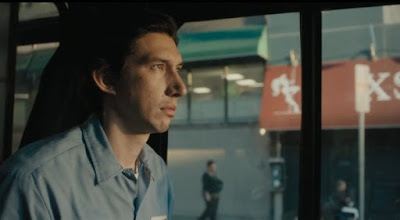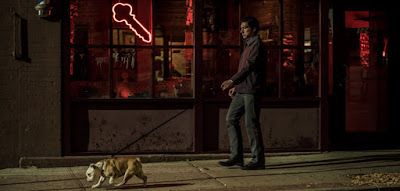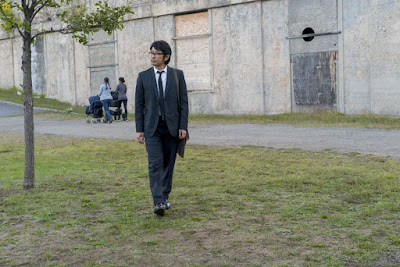Paterson would appear to be a simple tale; but it is not. It is a
film where Jim Jarmusch the original scriptwriter over-shadows Jim Jarmusch the
director. Yet they are both the same individual in two roles. The script is
trenchant; it is brilliant. The direction follows the script. A script on a
week in the life of a bus driver who writes poetry.
 |
| Bus driver Paterson (Adam Driver) at work |
 |
| Optimistic, poetic Paterson lives in Paterson City, where commercial activity obviously is in distress (see signage on the walls) |
Why is this original script
brilliant? Paterson, in the movie, refers to several things—it is the name of
the lead character (the bus driver and amateur poet); it is the name of the city
in New Jersey, USA, where the story takes place; it is the name of the volume
of the collection of poems of Pulitzer Prize winning US poet William Carlos
Williams who worked as a paediatrician in Paterson, New Jersey.
Scriptwriter
Jarmusch’s lead character is a bus driver who likes poetry, writes poetry, and
lives in a house with book shelves full of books of poetry by Williams and
other poets. A 10-year-old girl with a penchant for writing poetry in a secret
notebook who meets Paterson for the first time amiably describes him after the
brief encounter as “a bus driver who likes Emily Dickinson” (the poet). The bus
driver writes his poems in his own secret notebook, before and after driving
his bus. These poems are odes to his partner Laura, of Iranian lineage. Now,
Jarmusch’s choice of the name Laura for bus driver Paterson’s partner is not
accidental—the Renaissance Italian poet Petrarch (1304-74) too wrote all his
poems to his muse Laura de Noves, the wife of a Count, whose beauty made
Petrarch leave priesthood even though their relationship was platonic.
 |
| Laura (Golshifteh Farahani) paints and wears black and white and even put black and white icing on her cupcakes |
Jarmusch’s creation of Laura is
equally amazing. Laura is equally a creative individual as Paterson is. She
loves to paint at home with white and black colours. She goes to the extent of
painting her clothes while wearing them. When she bakes cupcakes, the icing is
again black and white. Even her guitar that she orders on-line is painted black
and white! When she takes her spouse Paterson to a movie—the movie is in black
and white. Yet Laura is odd—she is devoted to her husband and recognizes his
gift for poetry. She is equally devoted to her pet dog. Her life seems fairly limited to home
management and an interest in music. Yet she manipulates her husband to agree
to buy a costly guitar on-line but makes up for the cost by making equal or
more money selling cupcakes at the local farmer’s market. And guess what? She had dreamt it first.
Now writer Jarmusch elegantly
contrasts the life of the loving couple, who love each other intensely, despite
their quite different likes and dislikes, constantly encouraging and supporting
each other, while other couples in Paterson do not seem to get along with as
much élan despite being together. The love between Paterson and Laura helps the
bus driver Paterson to see beauty in ordinary objects and mundane situations.
 |
| Marvin the dog on a Persian carpet at home. (The dog got a rare award at Cannes! And the film is dedicated to it, as well) |
 |
| Paterson (Driver) takes Marvin out for a walk, before entering a pub for his daily glass of beer |
The third most important character
in the script is an English bulldog called Marvin who waits outside the pub
dutifully each evening as Paterson has his daily glass of beer. The dog is apparently
fond of Laura more than Paterson. But the apparently docile dog is cunning
enough to make Paterson wonder who is tilting his mailbox. And when Marvin is
left alone in the house he wreaks revenge on Paterson the bus-driver in his own
way.
Laura recollects having dreamt of
having twins with Paterson. The script introduces us to several pairs of twins
in Paterson and motley people all interested in writing poetry. The sets of twins
include elderly men sitting on a bench, passengers on the bus, twins in the pub,
the 10-year old girl poet who possibly has a twin sister, and so on. Poets include
a 10-year-old girl, a man waiting to get his laundry washed, and a tourist. The
recurrence make you marvel at Jarmusch’s interest in adding details that would have
been inconsequential in most other screenplays.
 |
| Paterson (Driver), having lost his secret notebook. gazes at the waterfall in solitude |
 |
| Japanese actor Masatoshi Nagase as a Japanese poet, arrives at the waterfall viewing site and later sits down with Paterson and discusses poetry. |
All that, of course, would be
limited to characters and character development. Towards the end, the script
shifts gears as it introduces magic realism. Peterson, who has lost his secret
poetry notebook, wistfully gazes at the waterfall in Paterson city, sitting
alone on the bench. An amazing encounter with a Japanese poet leads to Paterson
being gifted with an empty notebook—as though the tourist knew of Paterson’s recent
loss. Paterson the bus driver-cum-poet renews his writing after this unexpected
gift from a guardian angel—a tourist who is meeting him for the first time.
The final line Paterson writes is “Would you be a fish?” This might
intrigue many people viewing the film. A fish might look good but it cannot
read or write. And in spite of its agility in the water it can get caught and
end up as food. Ergo: being a poet is better than being a fish.
 |
| The importance of supportive couples is contrasted with one that does not |
A word about the actors in Paterson. Is the casting of Adam Driver
as the bus driver a mere coincidence? Is the casting of the Iranian actress Golshifteh
Farahani as Laura who dreams of Asian images of elephants and furnishes her
floors with Persian carpets, another coincidence? Is the casting of the
Japanese actor Masatoshi Nagase [the lead actor in Naomi Kawase’s equally
reflective Japanese film Sweet Bean
(2015)] yet another coincidence? Quite evidently Jarmusch builds on details
while writing his script, while casting and directing.
This film establishes Jim Jarmusch
as one of the top two directors working in USA today alongside Terrence
Mallick.
P.S. This critic is disappointed
that this original screenplay did not even get nominated for an Oscar. It is
far superior to others that were nominated in 2017. The film is one of the best
films made in 2016. Unfortunately, this critic viewed it only in 2017 and, therefore, Paterson is likely to find a place in the top 10
films of 2017 of this critic. Earlier on this blog, this critic had reviewed Naomi
Kawase’s Sweet Bean (2015) with actor Masatoshi Nagase.

No comments :
Post a Comment